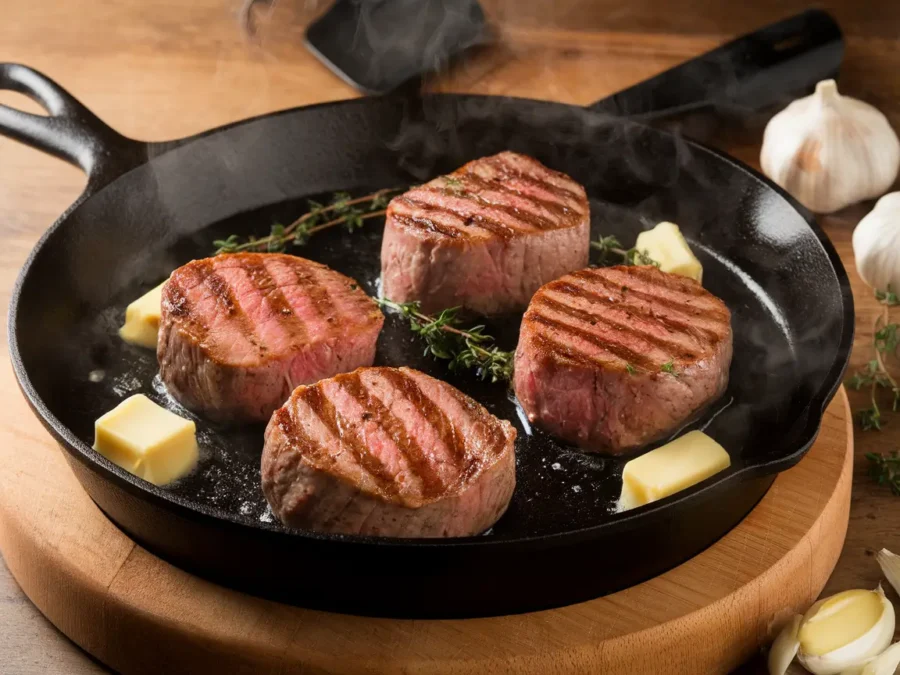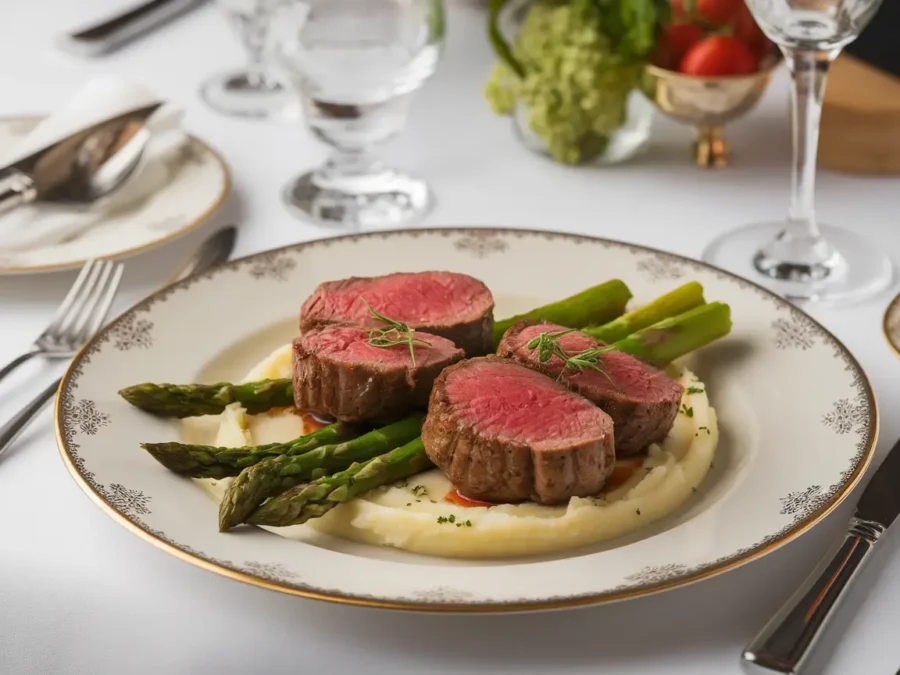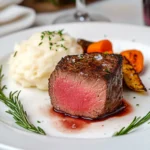Filet medallions, often synonymous with sophistication and culinary excellence, are small, tender cuts of beef prized for their flavor and delicate texture. Whether served at high-end restaurants or prepared in the comfort of your home, they have an unmatched versatility that makes them ideal for special occasions and everyday indulgences alike.
In this comprehensive guide, we’ll delve deep into everything you need to know about filet medallions. From selecting the right cut to mastering essential cooking techniques, we’ll cover all the details step by step. Additionally, we’ll explore perfect flavor pairings, creative sauces, and even provide mouthwatering recipes you can easily try at home. As we take this flavorful journey together, you’ll gain a deeper understanding of what makes filet medallions a standout choice for gourmands worldwide. So, let’s dive in and uncover the secrets behind this culinary treasure.
Table of Contents
Understanding Filet Medallions
What Are Filet Medallions?
Filet medallions are small, round portions of beef carefully cut from the tenderloin, which is a long and cylindrical muscle located along the spine of the cow. This specific section is highly renowned for being the most tender part of the animal, primarily because it bears minimal weight and does not engage in significant physical activity. Furthermore, the medallion shape is skillfully achieved by slicing the tenderloin into even, compact pieces, making them not only visually appealing but also incredibly easy to cook and serve. Consequently, filet medallions have become a favorite choice for both professional chefs and home cooks alike.
Their smaller size and uniform thickness make filet medallions an excellent choice for quick, precise cooking. They offer the same luxurious quality as a larger filet mignon but are often more affordable and versatile for different dishes.
Cuts of Beef for Filet Medallions
Filet medallions specifically come from the tenderloin, but it’s important to understand the different sections of this prized cut. The tenderloin can be divided into three parts:
- The Butt End: This is the largest section, offering slightly thicker medallions. It’s great for hearty presentations.
- The Center Cut: Known for its uniform shape and size, the center cut yields the most prized filet medallions, perfect for elegant plating.
- The Tail End: This thinner portion may not provide perfect medallions but can be used for smaller portions or recipes requiring diced beef.
When shopping for filet medallions, look for even marbling and a vibrant red color, as these characteristics indicate high-quality meat.
Preparing Filet Medallions
Choosing the Perfect Cut
Selecting the right filet medallion is key to achieving a mouthwatering result. When purchasing, consider these tips:
- Freshness: Opt for freshly butchered tenderloin when possible, as it offers superior flavor and texture compared to frozen cuts.
- Marbling: While filet medallions are naturally lean, subtle marbling enhances flavor without adding toughness.
- Thickness: Aim for medallions that are at least 1 to 1.5 inches thick for even cooking and juiciness.
Trimming and Shaping Medallions
Proper trimming is essential to ensure uniform cooking and an elegant appearance. Remove any silver skin a tough, fibrous membrane covering parts of the tenderloin using a sharp knife. Trim excess fat but leave a thin layer to prevent the meat from drying out during cooking.
To create perfectly round medallions, use butcher’s twine to tie each piece gently. This step helps maintain the medallion shape as it cooks, ensuring even browning and a polished final presentation.
Marinating for Maximum Flavor
While filet medallions boast natural tenderness, marinating can infuse additional flavors. For simple elegance, consider these marinade options:
- Classic Herb and Garlic: A mixture of olive oil, minced garlic, thyme, and rosemary adds a subtle earthy flavor.
- Soy and Ginger Marinade: A blend of soy sauce, fresh ginger, and a hint of honey introduces a savory-sweet profile.
- Red Wine and Shallot: A rich marinade combining red wine, shallots, and a touch of balsamic vinegar enhances the meat’s depth.
Marinate the medallions for 30 minutes to two hours, but avoid over-marinating, as the delicate texture can break down too much.
Cooking Filet Medallions
Pan-Searing to Perfection
Pan-searing is a popular method for cooking filet medallions because it locks in flavor and creates a beautiful crust. Follow these steps for flawless results:
- Heat a heavy skillet, such as cast iron, over medium-high heat until it’s hot enough to make water droplets dance.
- Add a tablespoon of oil or butter and wait until it shimmers.
- Season the medallions generously with salt and pepper, then place them in the skillet without crowding.
- Sear for 2-3 minutes per side to develop a golden-brown crust. Finish by spooning melted butter over the top for added richness.
For thicker cuts, transfer the skillet to a preheated oven (375°F) to finish cooking to your desired doneness.
Grilling Techniques
Grilling filet medallions imparts a smoky flavor that pairs beautifully with their natural tenderness. For best results:
- Preheat the grill to medium-high heat and oil the grates to prevent sticking.
- Season the medallions with a dry rub or simple salt and pepper.
- Grill each side for about 3-4 minutes, depending on thickness. Use a meat thermometer to ensure accurate cooking (125°F for rare, 135°F for medium-rare).
Baking Filet Medallions
Baking is ideal for recipes requiring additional toppings or sauces. Here’s how to bake filet medallions:
- Preheat your oven to 400°F.
- Sear the medallions in a hot skillet for 2 minutes on each side, then transfer to a baking dish.
- Add your desired topping like herb butter or a mushroom cream sauce and bake for 8-10 minutes for medium-rare doneness.
Baking allows the flavors to meld beautifully, creating a moist and flavorful dish.

Flavor Pairings and Sauces
Classic Sauces
Filet medallions shine when paired with complementary sauces that enhance their natural flavor. Some timeless classics include:
- Red Wine Reduction: A velvety sauce made by simmering red wine, beef stock, and shallots until it reduces to a rich, concentrated glaze.
- Bearnaise Sauce: A creamy, herbaceous sauce made with clarified butter, egg yolks, and a reduction of white wine, tarragon, and shallots.
- Peppercorn Sauce: A bold, creamy option that combines cracked black peppercorns, heavy cream, and a hint of brandy for a robust kick.
- Demi-Glace: A luxurious, slow-cooked reduction of beef stock and wine that adds depth to every bite.
Creative Seasonings and Rubs
If you’re looking for something outside the traditional realm, consider spicing things up with inventive rubs and seasonings:
- Coffee and Cocoa Rub: The subtle bitterness of coffee and cocoa complements the meat’s richness.
- Chimichurri: A zesty Argentinian herb sauce made with parsley, garlic, olive oil, and red pepper flakes for a tangy pairing.
- Smoked Paprika and Brown Sugar Rub: A slightly sweet and smoky blend perfect for grilling.
Side Dishes That Complement the recipe
The right side dish elevates a filet medallion meal from delicious to unforgettable. Consider these pairings:
- Garlic Mashed Potatoes: Creamy, buttery potatoes with a hint of garlic are a classic choice.
- Roasted Asparagus: Lightly seasoned asparagus spears provide a crisp, refreshing balance to the rich meat.
- Wild Mushroom Risotto: Earthy mushrooms and creamy risotto create a luxurious side to match the elegance of the medallions.
- Cauliflower Gratin: For a low-carb yet indulgent option, this cheesy baked dish is an excellent companion.
Nutritional Profile of Filet Medallions
Protein-Rich Goodness
Filet medallions are not just a treat for your taste buds they’re a powerhouse of nutrition. A typical 4-ounce serving provides:
- Approximately 23-26 grams of protein, which is essential for muscle repair and growth.
- Minimal fat content, with around 4-5 grams of fat, making it a leaner red meat option.
Caloric Information and Serving Sizes
Filet medallions are relatively low in calories compared to other beef cuts, with a 4-ounce portion containing about 200-250 calories. This makes them an excellent choice for health-conscious diners who want to enjoy red meat without overindulging. Pairing with nutrient-rich vegetables further balances the meal.
Filet Medallions in a Balanced Diet
Filet medallions fit seamlessly into a variety of dietary plans. Here’s how:
- Low-Carb/Keto Diets: Their high protein and low carb profile make them a staple for ketogenic meals.
- Athlete-Friendly Meals: The high protein content supports active lifestyles and recovery after workouts.
- Heart-Healthy Options: Choose grass-fed or lean cuts and pair with heart-friendly sides like spinach or quinoa to create a balanced meal.
Filet Medallions Around the World
Popular Variations and Regional Takes
Filet medallions are celebrated worldwide, and each region adds its own flair:
- France: Filet medallions are often served as “Tournedos Rossini,” topped with foie gras and drizzled with Madeira sauce.
- Argentina: Chimichurri sauce and wood-fire grilling techniques bring a bold, rustic flavor to this cut.
- Italy: “Tagliata di Manzo” features thinly sliced filet medallions served with arugula and Parmesan.
Famous Restaurants Featuring Filet Medallions
Several world-class establishments highlight filet medallions as a signature dish. Renowned steakhouses and gourmet venues often incorporate creative presentations and sauces that showcase the versatility of this cut. Their menus inspire home cooks and set culinary trends globally.
Tips for Buying beef medallions
Recognizing Quality Beef
To ensure you’re buying the best filet medallions, look for these indicators of quality:
- USDA Grade: Prime beef is the highest grade, offering superior tenderness and marbling. Choice grade is also an excellent option.
- Color: Vibrant red meat with a slight sheen indicates freshness. Avoid beef with a grayish tint.
- Texture: The surface should feel firm and smooth, with no slimy residue.
Sustainable Sourcing Options
For conscious consumers, sustainability is key. Look for:
- Grass-Fed Beef: Offers a leaner texture and is considered more environmentally friendly.
- Local Farms: Buying locally reduces carbon footprints and supports regional agriculture.
- Certified Humane Labels: Ensure ethical farming practices by checking for this certification.
Storing Filet Medallions Properly
To maintain freshness, store filet medallions in airtight packaging. For short-term storage, keep them in the refrigerator at 35°F to 40°F and use within 3-5 days. For longer preservation, wrap them in freezer-safe packaging and store at 0°F for up to six months.
Common Mistakes
Overcooking and Undercooking
One of the most common pitfalls when preparing filet medallions is missing the mark on doneness. Overcooking can result in a dry, tough texture that diminishes the meat’s natural tenderness, while undercooking may leave the center cold and unappetizing. To avoid these issues:
- Use a Meat Thermometer: This is the most reliable way to achieve perfect doneness. Aim for these internal temperatures:
- Rare: 120°F to 125°F
- Medium-Rare: 130°F to 135°F
- Medium: 140°F to 145°F
- Let the Meat Rest: After cooking, allow the filet medallions to rest for 5-10 minutes to let the juices redistribute, ensuring every bite is flavorful.
Seasoning Mishaps
Improper seasoning can either overwhelm the natural flavor of the meat or leave it bland. Here are some tips:
- Don’t Overdo the Salt: Season generously but evenly. Adding salt too early can draw out moisture, so it’s best to do it just before cooking.
- Avoid Overpowering Spices: Filet medallions have a delicate taste. Strong spices can overshadow their flavor. Opt for simple seasonings like sea salt, cracked black pepper, and fresh herbs.
Improper Handling of the Meat
Handling the meat incorrectly can impact both flavor and safety. Avoid these mistakes:
- Skipping the Room Temperature Step: Cooking cold filet medallions straight from the refrigerator can lead to uneven cooking. Let the meat sit at room temperature for 30-45 minutes before cooking.
- Using a Dull Knife: A sharp knife is crucial for trimming and cutting medallions to avoid tearing the delicate texture of the meat.
- Flipping Too Often: Let the medallions sear undisturbed for the first few minutes on each side to develop a proper crust. Flipping repeatedly prevents this from happening.
Recipes to Try at Home
Classic Filet Medallions with Herb Butter
This timeless recipe enhances the medallion’s flavor with the richness of herb-infused butter.
Ingredients:
- 4 filet medallions (1-inch thick)
- Salt and pepper, to taste
- 2 tbsp olive oil
- 4 tbsp unsalted butter
- 1 tsp minced garlic
- 1 tsp fresh thyme leaves
Instructions:
- Season the medallions generously with salt and pepper.
- Heat olive oil in a skillet over medium-high heat and sear the medallions for 3 minutes per side.
- Reduce heat to medium, add butter, garlic, and thyme to the skillet. Spoon the melted butter over the medallions continuously for 1-2 minutes.
- Rest for 5 minutes before serving.
Garlic and Rosemary Filet Medallions
This recipe combines the boldness of garlic and the earthiness of rosemary for a simple yet flavorful dish.
Ingredients:
- 4 filet medallions
- 3 garlic cloves, smashed
- 2 sprigs fresh rosemary
- 2 tbsp olive oil
- Salt and pepper, to taste
Instructions:
- Preheat the oven to 400°F.
- Heat olive oil in a skillet over medium-high heat, add garlic and rosemary, and sear the medallions for 2 minutes per side.
- Transfer the skillet to the oven and bake for 6-8 minutes for medium-rare.
- Rest for 5 minutes, then serve with roasted vegetables.

Frequently Asked Questions
What Makes Filet Medallions Different from Other Cuts?
Filet medallions are smaller, more tender portions of the tenderloin. Their compact size makes them versatile for various recipes, and they are leaner compared to other cuts like ribeye or strip steak.
How Long Should I Cook Filet Medallions?
Cooking time depends on thickness and desired doneness. A 1-inch-thick medallion takes about 2-3 minutes per side for medium-rare when pan-searing, plus additional time if finished in the oven.
What Are the Best Sauces for Filet Medallions?
Classic sauces like red wine reduction, bearnaise, or peppercorn cream are popular. For creative options, try chimichurri or a balsamic glaze.
Can I Freeze it ?
Yes, filet medallions can be frozen for up to 6 months. Wrap them tightly in freezer-safe packaging to prevent freezer burn.
How Do I Know When Filet Medallions Are Done?
Using a meat thermometer is the best way to check doneness. Medium-rare is achieved at 130°F to 135°F. Alternatively, press the meat lightly; it should feel firm but slightly springy.
Is It Better to Use Fresh or Aged Beef?
Aged beef enhances flavor and tenderness, making it a preferred choice for filet medallions. However, fresh beef can still deliver excellent results if cooked properly.
Conclusion
Filet medallions represent the pinnacle of fine dining, offering unmatched tenderness and a versatile flavor profile. Whether you’re a home cook or a gourmet enthusiast, these small yet mighty cuts can transform any meal into a memorable experience. By mastering preparation and cooking techniques, experimenting with pairings and sauces, and avoiding common mistakes, you’ll enjoy the full potential of filet medallions every time.
Pan-Seared Filet Medallions with Herb Butter
Ingredients
- 4 6-ounce filet medallions, about 1.5 inches thick
- Salt and freshly ground black pepper to taste
- 2 tablespoons olive oil
- 2 tablespoons unsalted butter
- 2 cloves garlic minced
- 1 tablespoon fresh rosemary chopped
- 1 tablespoon fresh thyme chopped
Instructions
- Pat filet medallions dry with paper towels.
- Season both sides generously with salt and freshly ground black pepper.
- Heat a cast iron skillet over medium-high heat until hot.
- Add olive oil to the skillet and heat until shimmering.
- Place the medallions in the skillet and sear for 3 minutes without moving them.
- Flip the medallions and sear the other side for an additional 3 minutes for medium-rare, or longer to reach desired doneness.
- Reduce heat to medium-low. Add butter, minced garlic, rosemary, and thyme to the skillet.
- Tilt the skillet slightly and spoon the melted herb butter over the medallions continuously for about 1 minute.
- Remove the medallions from the skillet and let them rest for 5 minutes before serving


